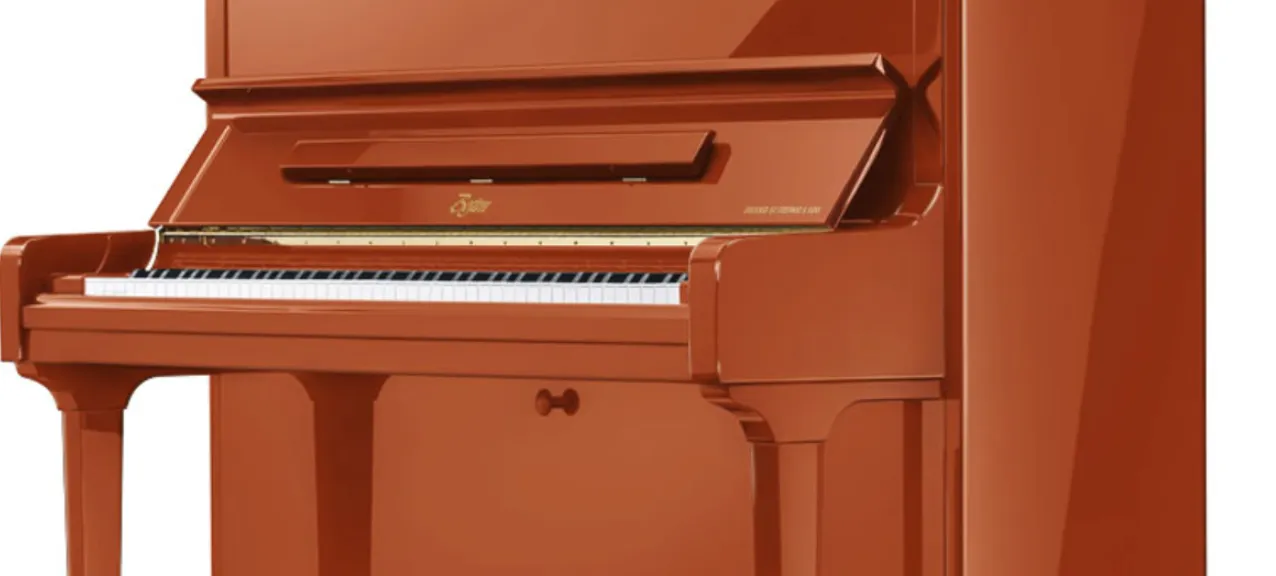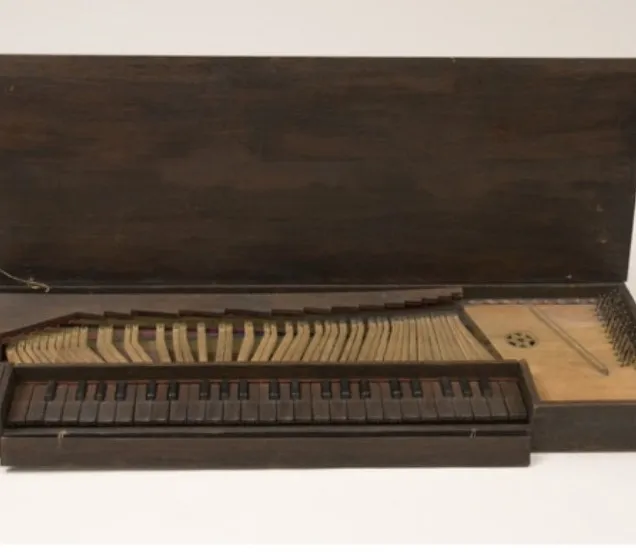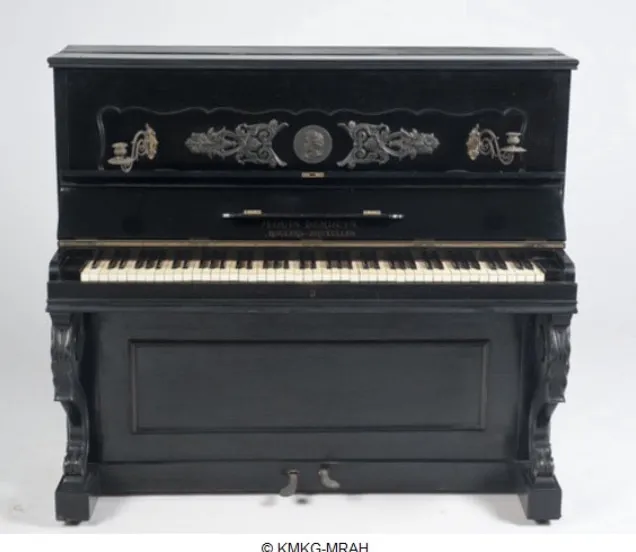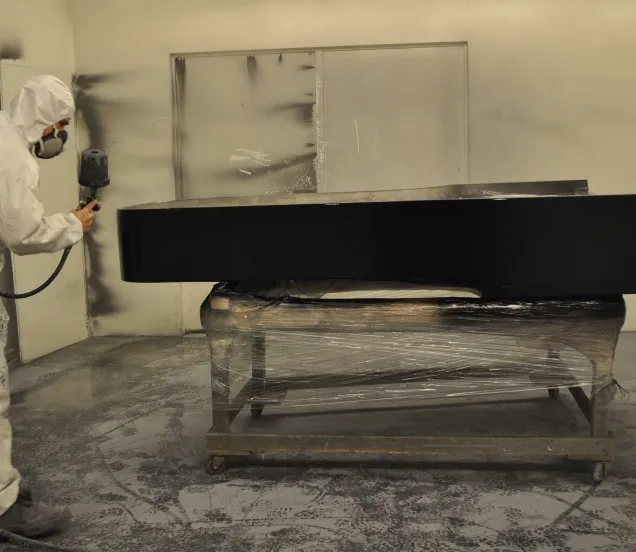Why are pianos (usually) black?
Steinway & Sons' subsidiary brand Boston temporarily offers a special service with Create Your Own: you can choose the colour of your piano entirely yourself (from more than 200 tones). A stroke of luck for someone looking for a unique piano.
But why are pianos usually black? Read all about it in this blog post!


In the beginning there was... colour!
In the past, keyboard instruments were not black at all. On the contrary! In the 16th and 17th centuries, harpsichords, virginals and other keyboard instruments were usually made of fine wood and beautifully carved. They were often painted, often with family scenes, slogans and sayings.
These keyboards were real showpieces, which were given a central place in the social rooms of the wealthy owners. Besides the sound, the furniture was also very important. So harpsichords, virginals and clavichords were real status symbols. This is very clear in this Chris Maene replica of a Hans Ruckers-virginal from the beginning of the 17th century.

The clavichord: a pleasantry for the bourgeoisie
From the end of the 17th century, the harpsichord became a real hype in the European cultural cities.
These small table instruments were much easier to transport and build than the large and heavy harpsichords. In cities such as Vienna and Florence, a flourishing middle class emerged and the harpsichord found its way into their (smaller) living spaces. Playing the harpsichord suddenly became a hobby that was not only reserved for the high nobility. The narrower budget of the new bourgeoisie was reflected in the building of the harpsichords.
Paying artists and woodcarvers to decorate a piano was expensive and time-consuming. So the cheaper instruments were built more soberly, and eventually they were often painted in one colour. Dark paint (especially black) was much cheaper than light and bright colours, and was also ideal for hiding imperfections and irregularities in the wood.
For a painted or varnished instrument, the aesthetic quality of the wood is much less important, so cheaper (but no less reliable) wood came into consideration as a building material. Moreover, a black finish discolours slower when exposed to sunlight than other colours.
Most harpsichords and later pianofortes were still produced in beautiful wooden and painted finishes in the 18th century. After all, this type of instrument was not reserved for the bourgeoisie.

The piano industry: back To Black.
Once the modern piano developed, it quickly became the most sought-after keyboard instrument throughout Europe. The first modern pianos from the beginning of the 19th century were mainly high-grade instruments intended for musicians, salons and concert halls. These instruments were mechanically more complex and much more difficult to rebuild, and hence much more expensive. Consequently, builders continued to choose ornamental designs and beautiful, precious woods that were varnished, lacquered or polished.
Soon, the demand for pianos among the general public grew, and this coincided with the introduction of machine production techniques: industrialisation had a great influence on piano building.
More and more families could afford to buy a piano. Piano building was therefore a booming industry. Thousands of piano factories were opened in Europe, and even in those days there was strong pressure on prices. For the same reasons as for harpsichords, pianos were built with simpler wood and with a black layer of paint or varnish. The above example is a black varnished piano by a local builder, Derdeyn from Roeselare (1855).
Gradually black pianos became very common, and even the best piano builders started to finish their pianos in black - but often in a high quality finish, such as polish. Such a polished finish is beautiful, but applying it is a genuine craft. A craft that we at Pianos Maene preserve dearly, which enables us to restore older instruments to their former glory!

By the middle of the 20th century, people had had enough of the carvings and baroque decorations in their furniture. Moreover, it was not worth the extra cost. Trendy interiors became increasingly minimalist, and pianos followed the same evolution. Clean lines became the norm, and plastics made their appearance in furniture construction.
Nowadays, polyurethane lacquer is the most common finish, from entry-level pianos to the absolute top instruments. Such a pu-lacquer lasts a very long time and can be repainted quite easily. The lacquer forms a hard, strong layer that can take a beating.
A white finish is also possible, but it will cost you a little more. It is slightly more difficult to finish a white lacquer instrument beautifully. Moreover, the demand for white instruments is much smaller, making the production lines more expensive.
Pianos in satin or polished finishes can still be bought (on order). These finishes are mainly used by top manufacturers such as Steinway & Sons, due to the high cost of the materials used and the labour-intensive process. For such an exclusive finish, you often pay a hefty surplus, but in return you get a unique instrument.
Steinway & Sons' daughter brand Boston is temporarily offering their buffet pianos in a colour of your choice under the heading "Made to Create". The pianos are finished in Germany in high-quality PU lacquer, and you can choose between around 200 colours. This way, you can take home a unique piano that perfectly fits your interior! More details can be found on the Boston website!


